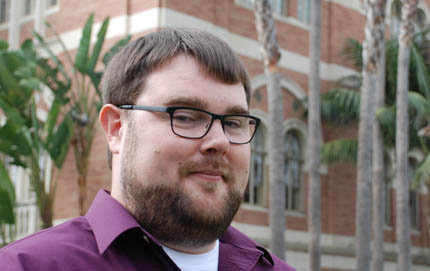Many dismiss the structure of Los Angeles as urban sprawl. But Samuel Krueger, a graduate of the GIST master’s program in USC Dornsife, disproves this notion by showing L.A.’s distinctive heart. His research has earned him awards from two renowned academic organizations.
By Michelle SalzmaWriter Dorothy Parker once haughtily dismissed Los Angeles as “72 suburbs in search of a city.” But USC Dornsife alumnus Samuel Krueger’s research shows that the City of Angels actually does have a focal point.
Krueger set out to analyze how Los Angeles fares as a structurally cohesive city from a scientific point of view for his thesis in the Geographic Information Science and Technology (GIST) master’s program in USC Dornsife.
“On an emotional level, I get tired of people saying that L.A. is not a real city, so I wanted to show that it has a center just like any other city does,” Krueger said.
His thesis, “Delimiting the Postmodern Urban Center: An Analysis of Urban Amenity Clusters in Los Angeles,” found that, indeed, a strong core center runs from Santa Monica to downtown Los Angeles. The path, which he dubs "The Wilshire/Santa Monica Corridor," is named for the two main arteries along which the city’s center is concentrated.
Krueger’s work has earned him two prestigious recognitions, one as first place winner of the UNIGIS 2012 Academic Excellence Award. The UNIGIS International Association is a global network of higher education institutions dedicated to enhancing the competence of geographic information science and systems professionals. The award recognizes the top master’s thesis from entries across the UNIGIS international network, of which the Spatial Sciences Institutebased in USC Dornsife is a founder.
Krueger also won the North American Regional Science Council’s 2012 Graduate Student-Author Paper Competition. As part of that honor, his paper will be considered for publication in the academic journal Papers in Regional Science.
Earning his bachelor’s degree in geography in 2003 and master’s in geographic information science in 2012, both from USC Dornsife, Krueger has been captivated by cities as far back as he can remember. On family trips he would steer everyone toward downtown areas to explore. As soon as he could drive he spent weekends scouting the neighborhoods around his hometown of Portland, Oregon.
“I’ve always been fascinated with the way cities work — the spatial and constructed layout,” Krueger said. “They’re made piece-by-piece by individuals making small decisions one at a time, but it ends up being this coherent unit with an identifiable structure. That’s really interesting to me.”
For his thesis, Krueger took a new approach to identifying a city’s center. Where many similar types of studies focus on employment centers or commuting patterns, he focused on the location of urban amenities in the Los Angeles metropolitan area. These urban amenities fell into five categories: entertainment, full-service restaurants, hotels and motels, trendy hangouts, and high culture.
“To me, what makes a city special is the culture that’s maintained in the center of it,” Krueger said. “Each city center is unique and has a unique culture that people can recognize, and I used urban amenities as an indicator of that cultural center.”
He then mapped those amenities and used them to calculate centrality scores, a method of scoring he developed to quantify the density of amenities in clusters throughout Los Angeles.
As a control, Krueger also calculated — and validated — how his methodology applied to Chicago and New York City.
“I wanted to analyze those two cities because everyone agrees they have really strong centers,” Krueger said. “I wanted to show that this works in Chicago and New York and then apply it to Los Angeles.”
John Wilson, director of the Spatial Sciences Institute in USC Dornsife, was a member of Krueger’s thesis committee along with USC Dornsife’s Karen Kemp, professor of the practice of spatial sciences, and Phil Ethington, professor of history.
“What’s novel about Samuel’s work is that he took cutting-edge spatial analysis tools and he thought about all of the different ways that you could think about a place as a focal point for a larger geographic area,” said Wilson, professor of sociology, civil and environmental engineering, computer science and architecture.
“His work demonstrates perfectly the enabling aspect of what we’re trying to do in the GIST program. We want our students to learn the fundamental science and then the technology, which is the implementation of that science, and apply it to knowledge discovery and synthesis, just in the way Samuel’s done.”
Kemp, Krueger’s thesis adviser, calls his work a thoughtful and careful application of geographic information science.
“Samuel developed a sophisticated approach to addressing the modifiable areal unit problem — a challenge for all statistical data that is aggregated into districts — which underlies much of demographic and socio-cultural spatial analysis,” she said.
Krueger, who now works in the Los Angeles Department of Water and Power’s water geographic information systems group, wasn’t surprised by his findings.
“To me, geography is kind of like noting the obvious and writing it down. I think we can all see the center that I identified.”
Plus, major cities like New York and Paris have their own unique definitions of cityhood, Krueger said.
“The center of Paris isn’t anything like Manhattan or Tokyo,” he said for example. “I don’t think Los Angeles has to look like Manhattan to be a real city. We have our own way of doing things.”
(See original article here)




